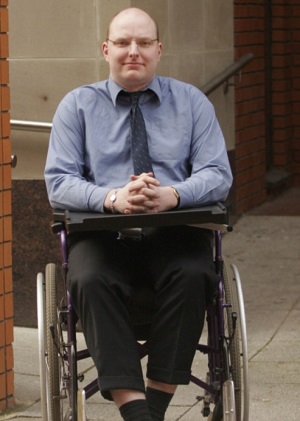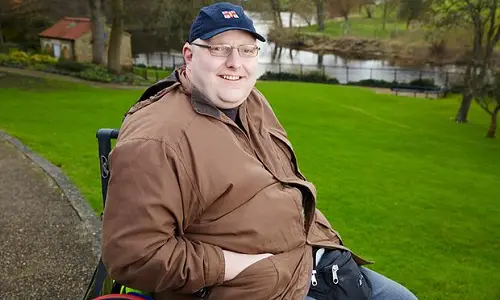
Q&A with disability-rights activist Doug Paulley
Independence is so important. But sadly it’s something that disabled people often have to fight for. Doug Paulley talks to Disability Horizons about his work as a disability-rights activist, and how you could also make a difference to your life and that of other disabled people.
Could you introduce yourself to Disability Horizons’ readers?
I’m Doug. I’m best known as that wheelchair guy that’s suing Firstbus in a case widely known as ‘Busgate’. I live in a care home in north Yorkshire, where my life revolves around food, campaigning, my cat, and beautiful train journeys around northern UK.
What prompted you to be a disability-rights activist and started you on your crusade against inequality?
I think it’s my parents. My family are staunch socialists who strongly believe in holding people accountable for their actions, particularly those in power. I am immensely proud of my mum, a retired community pediatrician, and my dad, a retired well-loved science teacher and local teaching union leader. They have both fought for the common person’s rights.
 I was also introduced to the immensely powerful concepts of the Social Model of Disability by the Ouch! podcast and local disabled people’s organisations in Leeds.
I was also introduced to the immensely powerful concepts of the Social Model of Disability by the Ouch! podcast and local disabled people’s organisations in Leeds.
The social model is a concept that was created by disabled people in the 1970s and states that the fundamental reason disabled are stopped from living life like everyone else is because society hasn’t made the required adjustments, not because of our medical conditions. So if you’re struggling to get up a kerb, the social model states the reason isn’t that you use a wheelchair, but that some thoughtless person failed to put in a drop-kerb.
Society’s failure to provide accessible transport, care/personal assistance, specialist equipment, adapted housing, inclusive education/training, access to an adequate income, accessible employment, access to appropriate health services and all other elements, is what makes us disabled.
There was one day when this concept suddenly clicked. I had a revelatory moment where I just got it – disabled people are being perennially stuffed by people who fail to make adjustments that enable us to do what everybody else already does, and that this is totally unacceptable. It was emancipatory to me. It still is.
How did you learn to start fighting for your rights as a disabled person?
To cut a long story short, the Disability Rights Commission (DRC), which helps disabled people fight for a society where disabled people can be equal citizens, helped me to challenge a local half marathon organiser that had failed to consider disabled people’s rights. The organisers were very defensive and very difficult to communicate with, and generally had a bad attitude towards me.
Through doing this, I learnt a lot about my rights, and eventually ended up taking a case to court using the DRC’s guide. I lost, but I then had a concrete idea as to what disabled people’s legal rights are and how the enforcement mechanisms theoretically work.
I have since taken on some 45 cases. Most of them have settled out of court, but a few reached court and I have subsequently won. There are also a few I have dropped, and a few that have reached court and I have lost. However, I think the real losses would have been if I hadn’t challenged things at all.
What does DART stand for and what is it?
DART stands for the Disability Attitude Readjustment Tool. It’s something I’ve written to help disabled people to take cases against service providers for disability discrimination that is counter to the Equality Act 2010. It’s intended to be a layperson’s guide (because I’m not a lawyer) on how to approach asserting one’s rights when a service provider isn’t doing what they should, and to challenge them through the small claims court if necessary.
It’s a free PDF/Word/MP3 document that may be used by disabled people who have experienced discrimination (relatively straightforward) by a service provider. For example, it could apply where the disabled person has been refused access to a service or the service provider has failed to make the required reasonable adjustment to their “polices, criterion or provisions” or to their physical features. It’s a plaster that I know doesn’t begin to cover the gaping hole that is the lack of realistic enforce-ability of our rights under the Equality Act 2010, but it’s a start.
It’s on my website at http://www.kingqueen.org.uk/dart.
Busgate: Where are you at and what’s next for Paulley vs. Firstbus?
Back in February 2012, I tried to catch a bus to go and see my parents for lunch. But despite the bus being nearly empty, I was unable to get on as somebody with a pushchair had got on just ahead of me and was occupying the wheelchair space. She refused to fold the pushchair, so I couldn’t catch the bus. Who would have dreamed that 4 a half years on, I would still be banging on about it in court and in the media?
I won a disability discrimination case against Firstbus at County Court, but then lost at the Court of Appeal. In my view though we did gain some theoretical extra rights on buses because of Lady Justice Arden’s judgment:
“The bus company must take all reasonable steps, short of compelling passengers to move from the wheelchair space. We have not had argument on this, but provisionally I consider that the bus company must provide training for bus drivers and devise strategies [so] that bus drivers can lawfully persuade people to clear the wheelchair space when needed by a wheelchair user.
Bus drivers have to use their powers of persuasion with passengers who can move voluntarily. The driver may even decline for a short while to drive on until someone moves out of the wheelchair space. There is no risk of liability to such passengers in requesting them (firmly) to move, if they can, because if they cannot safely do so, they will not do so.
The bus company should also have an awareness campaign and put up notices designed to make other passengers more aware of the needs of wheelchair users. It might also have to conduct surveys to find out when people are likely to travel and what their needs are so that it can do what it can to provide an appropriate number of buses for everyone.”
She said that because she was under the assumption that the above happens as a matter of course, this creates a binding precedent that bus companies must do all of this. Of course, we all know that this doesn’t happen, that wheelchair users are routinely turned away. The public perception is that wheelchair users “lost” the case, which has had a negative impact. Some buggy users and bus drivers are intransigent because they know that ultimately they aren’t legally obliged to vacate the space.
Now the case will be heard in the Supreme Court on June 15th. Do come along and support us outside! We’re hoping to get the judgment this side of Christmas (2016). It’s very important that we correct this injustice – not just for the specifics of access to buses, but also on the interpretation of the legal obligation that service providers must make reasonable adjustments.
Some people portray the case as wheelchair users vs pushchair users, but it isn’t. I’m up for transport being accessible to as much of the public as possible. Ultimately, however, if a disabled person wants to get on a bus but the wheelchair space is occupied, they may be prevented from getting on.
It’s a pain in the posterior to fold and pack up fold pushchairs, but it can usually be done (unless the parent or child’s impairment makes this unrealistic). People in wheelchairs don’t have that luxury: if that space isn’t available, they can’t travel.
Low floor buses, and wheelchair spaces, were brought about by disabled people in the 1990s when they quite literally chained themselves to inaccessible buses and blocked the roads in protest. The fact that we can’t reliably use the buses now, 25 years on, is bonkers. We hope that the Supreme Court case will right this.
The recent House of Lords review of the Equality Act 2010 was not happy reading. What do you think needs to happen to bring us closer to an equal society?
A cultural change. But therein lies the difficulty: achieving cultural change is a long, difficult process. We need to get everybody to realise and recognise that they have a responsibility to ensure that they make whatever adjustments are necessary to enable disabled people to have as much access to everything as everybody else.
In terms of the Equality Act, it needs better enforcement mechanisms. It cannot be right that the rights of disabled people are only enforceable by the individual disabled people who are discriminated against, taking legal action against individual providers.
Such a model was always bound to fail. Because disabled people face so many barriers in their lives, many don’t even realise that their treatment is unacceptable. And if they do, they’ll face the institutional bureaucracy of the Courts, and the seeming might and resources of the organisation discriminating against them. It’s truly a David and Goliath battle.
We need other organisations – user led organisations, regulatory organisations– to be empowered (and in some cases obliged) to challenge discrimination whenever it occurs.
If we eat a poorly-cooked kebab and get the squits, we blame the food provider. We also say; “hang on how come the takeaway’s got a good Scores on the Doors assessment? And why hasn’t it been inspected recently?’ But when I can’t find and book an accessible hotel because hotel information and booking websites is rubbish, as well as blaming the website why can’t I say; “hang on, how come the accessibility inspector has given this website a ‘pass report’? When was it last assessed?” Why is it that disability access is not given the same attention and enforcement as tax, health and safety, HR procedures, insurance and all the rest of it?
At the end of the day, it comes down to attitude. Unless and until accessibility is considered as a core part of the design and provision of every service – just as accounting procedures are – then it will always be an afterthought. And that’s not acceptable.
What advice would you give to someone who is considering taking legal action for the first time?
Give it a go! Don’t let the legal side of it and the intimidation of the system wear you down, no matter how big either are! They rely on the seeming complexity and intimidation to put you off. But if you go ahead, it doesn’t half wrong-foot people! The financial risks are minimal too.
It can be a useful tactic to achieve change. There’s something wonderfully empowering about forcing a provider to consider things in a way it never has before. To see accessibility not as a ‘nice to have’ but is a legal right. A service provider is breaking the law by failing to make its service accessible.
But be ready for any brickbats thrown your way. Whenever anybody challenges the status quo, it’s sadly the case that you may be targeted. This may be strategic, for example there’s an increasing tendency of defendants to force disabled people to go into degrading detail to ‘prove’ their disability in court as a deterrent to disabled people taking action. Or it may be more psychological – it is easier for defendants to brand the claimant as a troublemaker, a mercenary using court action to get a financial benefit, than it is to own that their behaviour has been in any way inappropriate, let alone discriminatory.
Also be ready for it to take a looooonnng time. And the risks to your headspace can’t be quantified – the ‘sticks and stones’ motto only works so much.
It’s still great though! Speak truth to power. Use the state’s own tools to force change – there’s no feeling quite like it.
By Fleur Perry
Visit Doug’s blog for more information on his work as a disable activist. If you have a case you want to fight, Doug’s DART document and the Equality and Human Rights Commission are good places to start.
